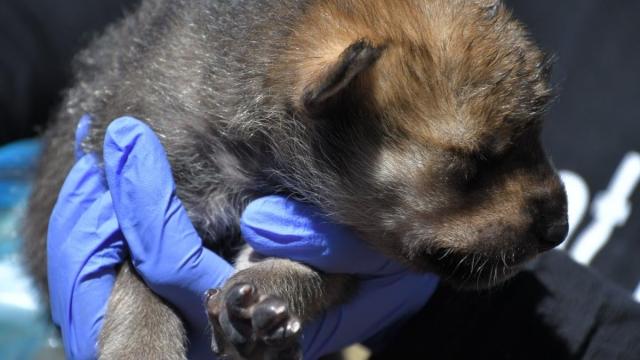The future of Mexican wolves in the U.S. Southwest is partly in the hands, or paws, of 11 adorable wolf pups. In early May, the small captive-bred canines were placed into the dens of five wild wolf packs across Arizona and New Mexico.
This introduction is part of the U.S. Fish and Wildlife Service’s “cross-fostering” program, which aims to introduce genetic diversity to the country’s struggling wolf population. The agency placed the pups in wild dens around the time that the wild wolves tend to give birth to their own offspring, which is usually during April and May. This is the seventh year of the program, and so far, pup survival rates have been around 50%, according to the FWS. This rate is in line with that of wild-born pups, as only about half survive their first year.
“Once all of the pups are placed back into the wild den, the breeding female’s maternal instinct kicks in,” the FWS explained in a press release. “She will feed and care for both the wild and captive-born pups. With the help of her pack mates, the pups will be raised with the skills and knowledge needed for a life in the wild.”
The introduction of new genes means better health outcomes for future wolves. Wolf populations in the U.S. crashed in the 1800s and 1900s due to habitat loss and killings by ranchers.
Some conservationists argue that opening up more space for wild wolves to roam, so that they can naturally intermingle with other packs, should also part of a population growth strategy. Before highways and human-made barriers, wild wolf packs were able to roam several states’ worth of territory.
“I think if they expanded the area in which they release wolves, that would give them the opportunity to select genetically healthy individuals from the captive population,” Carlos Caroll, a wolf biologist told AZ Central. “Actually releasing adult pairs with pups would give them a lot more scope to increase the diversity in the population.”
Other states have worked on their own wolf repopulation projects. In 2020, Colorado residents voted in favour of an initiative to reintroduce wolves to the state by 2023. The wolves may have felt a vibe shift, as after the vote, official recorded the first native born grey wolves in the state since the 1940s.
The recently placed pups, who were less than a month old, are too little to be collared, but genetic samples can be used to identify them when they’re older. The pups and their new packs can then be monitored by GPS and remote cameras to see if new offspring have successfully resulted from the program, according to the FWS.
The program is already showing some small promising results. By the end of 2021, there were almost 196 Mexican wolves in what FWS calls the “Mexican Wolf Experimental Population Area,” a 5% population increase from the 186 wolves recorded in 2020. Here’s wishing for the best for those 11 little wolves.
